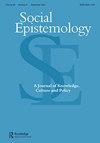Enacting Practices: Perception, Expertise and Enlanguaged Affordances
IF 2
2区 哲学
Q1 HISTORY & PHILOSOPHY OF SCIENCE
引用次数: 0
Abstract
ABSTRACTThe paper thematizes basic content-free cognition in human social practices. It explores the enlanguaged dimension of skilled practical doings and expertise by taking the minimal case of concept-based perception as its starting point. Having made a case for considering such activity as free of mental content, I argue in favor of the abolishment of the distinction between truth-telling and social consensus, thus questioning the assumption held by proponents of Radical Enactivism, namely that truth and accuracy conditions are restricted to content-involving activity. Instead, I claim, even content-free practical activity can be evaluated on the basis of accuracy conditions which ultimately tie with agents’ practical understandings and the normative aspects of the practice. With this as my backdrop, I explore how expertise arises in the interplay of enlanguaged affordances, concept-involving perception and the normative accuracy conditions that constrain a particular practice.KEYWORDS: Expertisecontent-free cognitionEnactivismpractices Disclosure StatementNo potential conflict of interest was reported by the author(s).Notes1. Concrete concepts such as ‘cat’, ‘house’ and ‘cucumber’ differ fundamentally from abstract concepts such as ‘freedom’, ‘language’, ‘human rights’, ‘beauty’, ‘politics’, etc. which are all devoid of concrete sensory referents (cf. Paivio Citation1986).2. The fact that Heidegger’s work resonates with anti-representationalist positions is well-known (see, Clark and Toribio Citation1994, 406).3. Indeed, there are also non-basic as-structures and this relates to the distinction between the pre-predicative and predicative. For as Engelland (Citation2020) argues, ‘The statement, “There’s a bird in the store!” makes explicit the part-whole relation resident in the experience of bird and of store. Predication (the apophantic is of S is p) remains founded on pre-predicative explication (the hermeneutic as of taking S as p)’ (10) Relatedly, Heidegger points out that ‘the “as” does not first show up in the statement, but is only first stated, which is possible only because it is there as something to be stated’ (Heidegger Citation2010, 145). So, a statement such as ‘I see this thing as a hammer’ contains to the very least as-structures on two levels: first, there is the pre-predicative, hermeneutic experience of the thing as a hammer which motivates the statement in the first place and, then, the thematization of this ‘as’ in the statement. In fact, we could go even further and argue that in the context of the statement, ‘this thing’ is taken as or understood as a Subject while ‘a hammer’ is taken as a predicate. This suggests that there are different as-structures in play whenever we are articulating statements based on our experiencing of things as somethings.4. A simulator is defined as: ‘the imitative representation of the functioning of one system or process by means of the functioning of another’ (https://www.merriam-webster.com/dictionary/simulation). While an appeal to ‘representation’ can be misleading in the current context, I prefer the term ‘performance’ instead. Professional training practices (such as flight simulators, medical simulations, war simulations etc.) that replace and enhance actual working practices are all examples of praxis simulators.5. Needless to say, it doesn’t follow that the salesperson is actually lying. Indeed, the customer’s suspicion may be entirely ungrounded and simply caused by their lack of knowledge about cars, bad experiences from buying used cars in the past or the general negative reputation of used car salespeople.6. See Gahrn-Andersen (Citation2021b) for an example of the fact that expertise may entail the construal of as-structures different from those available to non-experts. The example is that of a leakage-detection worker in a utility company who indexically associates the melting of snow on a street with leaking heating pipes thus allowing him to conceptually perceive the melding of snow as a ‘possible leakage’. So, whereas most people would simply see a plot of melted snow, the professional sees a leakage thanks to his expertise.Additional informationFundingThis work was supported by the Velux Foundations under [Grant 38917].Notes on contributorsRasmus Gahrn-AndersenRasmus Gahrn-Andersen is Associate Professor at the Department of Culture and Language (University of Southern Denmark). He is currently researching human socio-practical activity from an interdisciplinary perspective. More specifically, he explores phenomena such as concept and non-concept involving perception, basic and distributed cognition, social organizing, human-technology entanglements and how linguistic competencies and skills enable human practical behavior.制定实践:感知、专业知识和语言支持
摘要本文对人类社会实践中基本的无内容认知进行了主题化研究。它以基于概念的最小感知为出发点,探索熟练实践行为和专业知识的语言维度。在论证了这类活动不包含心理内容之后,我主张废除讲真话和社会共识之间的区别,从而质疑激进激进主义支持者所持的假设,即真理和准确性条件仅限于涉及内容的活动。相反,我主张,即使是无内容的实践活动也可以根据准确性条件进行评估,这些条件最终与行动者的实践理解和实践的规范方面联系在一起。以此为背景,我将探讨专业知识是如何在语言支持、概念感知和限制特定实践的规范准确性条件的相互作用中产生的。关键词:专家无内容认知行为实践披露声明作者未报告潜在的利益冲突。诸如“猫”、“房子”和“黄瓜”等具体概念与诸如“自由”、“语言”、“人权”、“美”、“政治”等抽象概念有着根本的区别,这些概念都缺乏具体的感官所指物(参见Paivio Citation1986)。海德格尔的作品与反表征主义立场产生共鸣的事实是众所周知的(见Clark and Toribio citation1994,406)。事实上,也有非基本as结构,这与前置谓语和谓语之间的区别有关。正如Engelland (Citation2020)所说,“这种说法,‘商店里有一只鸟!明确了驻留在鸟类和储存经验中的部分-整体关系。谓词(S is p的象形结构)仍然建立在前谓词解释(将S作为p的解释学结构)的基础上(10)。与此相关,海德格尔指出,“‘as’并不首先出现在陈述中,而只是首先被陈述,这是可能的,只是因为它作为某种东西存在于那里。”(海德格尔引文2010,145)。所以,像"我认为这个东西是一把锤子"这样的陈述至少包含了两个层面上的作为结构:首先,作为锤子的东西的先行谓词,解释学经验首先激发了这个陈述,然后,这个"作为"在陈述中的主题化。事实上,我们还可以进一步说,在这句陈述中,"这东西"可认作或理解为主词,而"锤子"可认作谓词。这表明,当我们基于对事物作为事物的经验来表达陈述时,就会有不同的作为结构在起作用。模拟器被定义为:“通过另一个系统或过程的功能来模拟一个系统或过程的功能”(https://www.merriam-webster.com/dictionary/simulation)。虽然在当前的背景下,对“表现”的呼吁可能会产生误导,但我更喜欢“表现”这个词。代替和加强实际工作实践的专业训练实践(如飞行模拟、医疗模拟、战争模拟等)都是实践模拟器的例子。不用说,这并不意味着销售人员实际上是在撒谎。事实上,顾客的怀疑可能完全没有根据,仅仅是由于他们对汽车缺乏了解,过去购买二手车的不良经历或二手车销售人员的普遍负面声誉所致。参见Gahrn-Andersen (Citation2021b)的一个例子,说明专业知识可能需要对与非专家不同的as结构进行解释。例如,公用事业公司的泄漏检测人员将街道上的雪融化与供暖管道泄漏联系起来,从而使他在概念上将雪融化视为“可能的泄漏”。所以,虽然大多数人只会看到一片融化的雪,但专业人士由于他的专业知识而看到了泄漏。本研究得到了Velux基金会[Grant 38917]的支持。作者简介rasmus Gahrn-Andersen,南丹麦大学文化与语言系副教授。他目前正在从跨学科的角度研究人类社会实践活动。更具体地说,他探讨了涉及感知的概念和非概念、基本和分布式认知、社会组织、人类技术纠缠以及语言能力和技能如何使人类的实际行为成为可能等现象。
本文章由计算机程序翻译,如有差异,请以英文原文为准。
求助全文
约1分钟内获得全文
求助全文
来源期刊

Social Epistemology
Multiple-
CiteScore
2.60
自引率
17.60%
发文量
60
期刊介绍:
Social Epistemology provides a forum for philosophical and social scientific enquiry that incorporates the work of scholars from a variety of disciplines who share a concern with the production, assessment and validation of knowledge. The journal covers both empirical research into the origination and transmission of knowledge and normative considerations which arise as such research is implemented, serving as a guide for directing contemporary knowledge enterprises. Social Epistemology publishes "exchanges" which are the collective product of several contributors and take the form of critical syntheses, open peer commentaries interviews, applications, provocations, reviews and responses
 求助内容:
求助内容: 应助结果提醒方式:
应助结果提醒方式:


